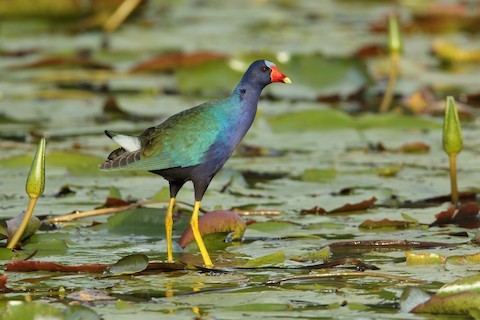Birdfinding.info ⇒ Locally common across much of its large range, mostly in areas with extensive floating vegetation. In Florida, common year-round in interior wetlands from around Orlando south, especially in the Everglades at sites such as Green Cay Wetlands and Loxahatchee National Wildlife Refuge. Also common in marshlands east of Houston, including Anahuac, Cameron Prairie, and Lacassine National Wildlife Refuges.
Purple Gallinule
Porphyrio martinica
Freshwater wetlands from southern North America to Argentina, usually associated with floating vegetation.
In North America, breeds on the coastal plain of the southeastern U.S. from South Carolina south through Florida and west to Texas, locally in bottomlands inland to southeastern Oklahoma and southern Arkansas. Present year-round along the Gulf Coast and throughout Florida; elsewhere in summer only.
In Middle America, resident in Pacific lowlands north to Nayarit, locally in western interior valleys to Guanajuato, and throughout the Gulf and Caribbean lowlands. Also throughout the West Indies on islands with freshwater marshes.
In South America, resident in Pacific lowlands south to Ecuador, and widespread throughout the continent’s northern, central and eastern lowlands south to the vicinity of Buenos Aires, Argentina.
Movements. Partly migratory in the northern part of its range, moving north from March to May and south from August to October.
Prone to wandering, in both spring and fall, north across most of eastern North America—regularly to Bermuda, the Great Lakes, and the Maritimes, exceptionally to the interior of Quebec and Labrador.
In western North America, strays fairly regularly north and west across Mexico and into Arizona, more exceptionally to California, Nevada, Utah, Colorado, and Wyoming, with at least one having reached Hawaii (Maui in February 2018).
In South America, strays regularly from lowlands up into high Andean valleys, to the Pacific lowlands of Peru and northern Chile, to the Galápagos, and exceptionally south to southern Patagonia and the Falkland Islands.
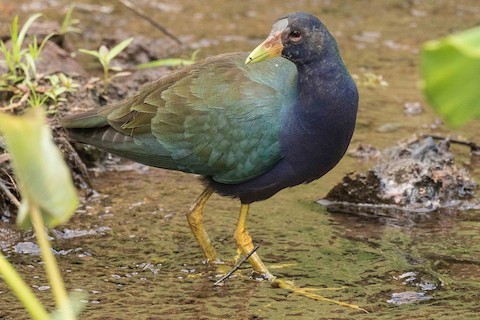
Purple Gallinule, subadult—first record for Hawaii. (Waihee-Waiehu, Maui, Hawaii; February 26, 2018.) © Eric VanderWerf
Across the Atlantic, it is a fairly frequent vagrant to Macaronesia (records from Azores, Madeira, the Canary Islands, and Cape Verde) and western Europe, north to Iceland and Norway, and inland to Switzerland, with at least one having reached South Africa (Port Edward, KwaZulu-Natal in November 2004).
Identification
Adult is distinctive: a beautiful combination of deep violet and indigo from head to breast with shiny blue-green back and wings, and a tricolored “candy corn” bill.
The bill is mostly red with a yellow tip and blue-gray frontal shield.
The upperparts are most typically blue-green but vary from deep-blue to turquoise to bronzy or brownish.
The lower belly is black, contrasting with prominently bright-white fluffy undertail.
The legs and feet are bright yellow and disproportionately large, especially the toes.

Purple Gallinule. (Anahuac National Wildlife Refuge, Texas; April 19, 2017.) © Stoil Ivanov

Purple Gallinule. (Tyrrell Park, Beaumont, Texas; September 10, 2020.) © Harlan Stewart

Purple Gallinule. (Bermejas Wildlife Refuge, Matanzas, Cuba; March 27, 2019.) © Forrest Rowland

Purple Gallinule, showing typically blue-green-and-brownish upperparts. (Tamiami Trail, Florida; April 2, 2017.) © Omar Paez
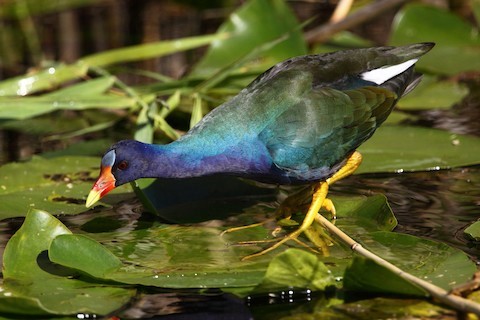
Purple Gallinule, showing typically blue-green-and-brownish upperparts. (Anhinga Trail, Everglades National Park, Florida; December 1, 2011.) © Bruce Robinson
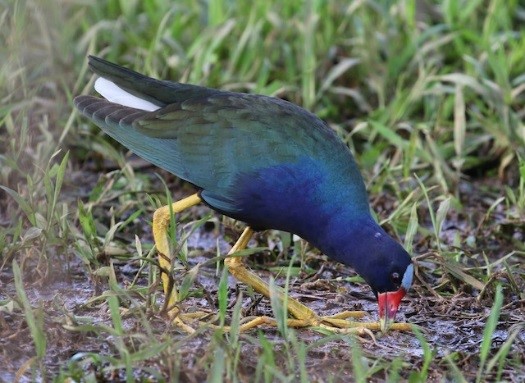
Purple Gallinule, showing typically blue-green-and-brownish upperparts. (Caño Negro Wildlife Reserve, Costa Rica; January 29, 2018.) © Carol Ortenzio
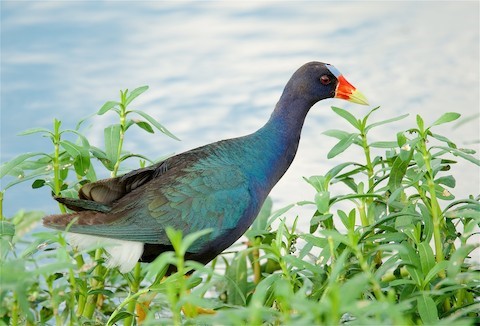
Purple Gallinule, showing typically blue-green-and-brownish upperparts. (Tyrrell Park, Beaumont, Texas; July 23, 2019.) © Harlan Stewart
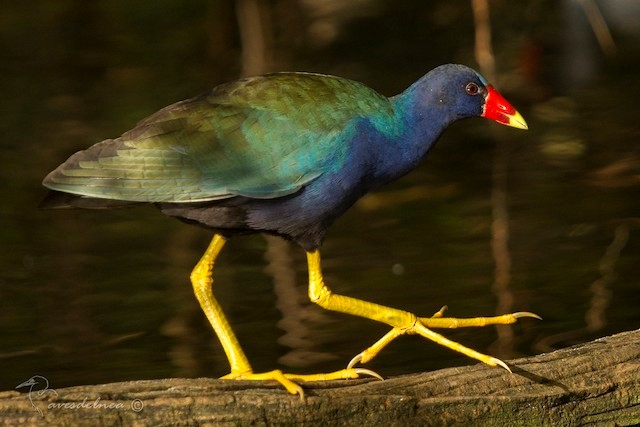
Purple Gallinule, showing extensively bronzy upperparts. (Bávaro, Dominican Republic; January 18, 2018.) © Aves del NEA
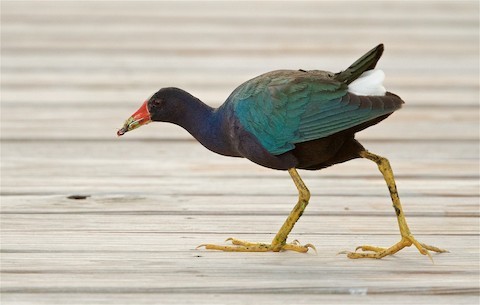
Purple Gallinule, showing typically blue-green-and-brownish upperparts. (Tyrrell Park, Beaumont, Texas; June 14, 2020.) © Harlan Stewart

Purple Gallinule, showing unusually vivid-blue upperparts. (Bubali Bird Sanctuary, Aruba; June 28, 2018.) © Philip Reimers
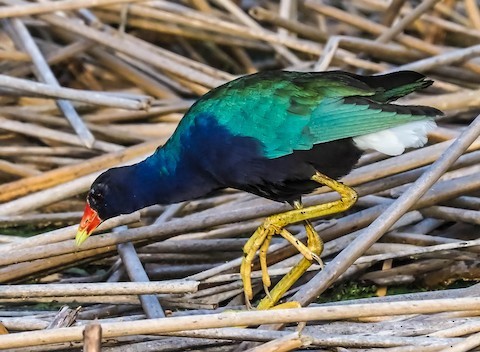
Purple Gallinule, showing unusually bright turquoise upperparts. (Brazoria National Wildlife Refuge, Texas; July 24, 2017.) © Dwayne Litteer
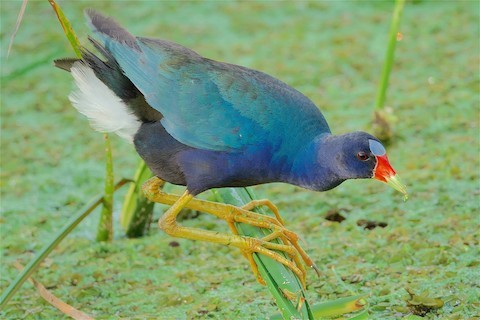
Purple Gallinule, showing vivid turquoise upperparts. (Tyrrell Park, Beaumont, Texas; August 9, 2020.) © Harlan Stewart
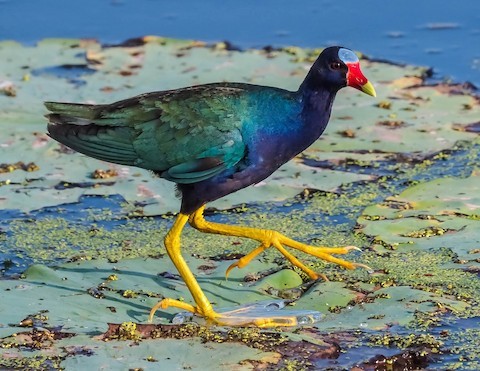
Purple Gallinule, showing vivid blue-green upperparts. (Anahuac National Wildlife Refuge, Texas; July 28, 2017.) © Dwayne Litteer
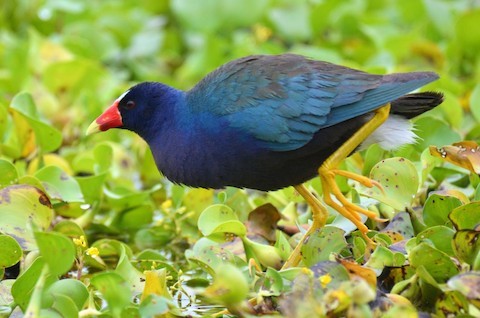
Purple Gallinule, showing mostly vivid blue upperparts. (Brazos Bend State Park, Fort Bend County, Texas; April 22, 2018.) © Jeff Sexton
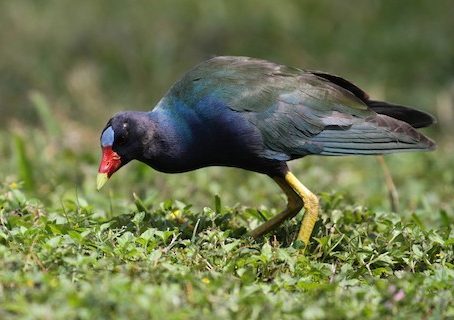
Purple Gallinule, with unusually dark, dull upperparts. (World Birding Center, South Padre Island, Texas; May 1, 2018.) © Alex Lamoreaux
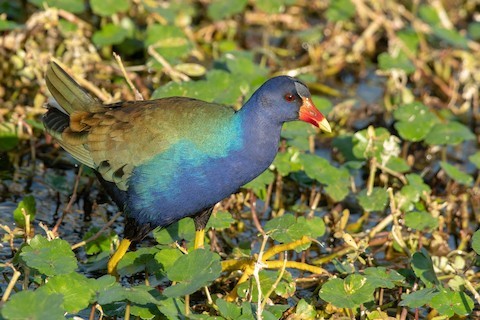
Purple Gallinule, showing extensively bronzy upperparts. (Sweetwater Wetlands Park, Gainesville, Florida; December 8, 2019.) © Courtenay Harding
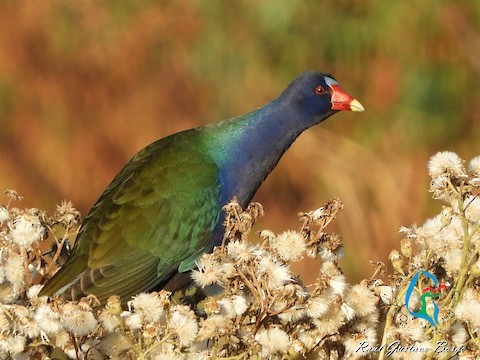
Purple Gallinule, showing extensively bronzy upperparts. (La Paz, Entre Ríos, Argentina; October 28, 2018.) © Raúl Gustavo Borgo

Purple Gallinule, showing extensively bronzy upperparts. (Tyrrell Park, Beaumont, Texas; March 23, 2020.) © Harlan Stewart

Purple Gallinule, showing extensively bronzy upperparts. (Belize City, Belize; August 13, 2019.) © Francis Canto Jr.
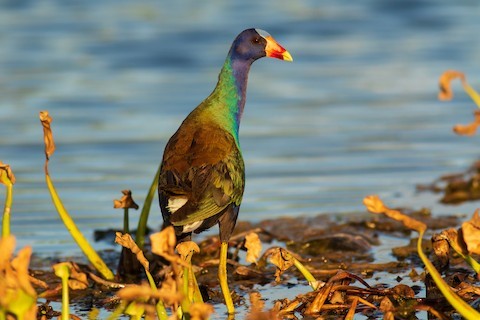
Purple Gallinule, showing maximally bronzy upperparts and rainbow iridescence on the neck. (Belize City, Belize; August 13, 2019.) © Francis Canto Jr.

Purple Gallinule, showing mostly blue upperparts. (Wakodahatchee Wetlands, Palm Beach County, Florida; April 24, 2004.) © Chris Wood

Purple Gallinule, showing extensively bronzy upperparts and pale turquoise wings. (South Pear Orchard Road, Chambers County, Texas; August 4, 2017.) © Gil Ewing
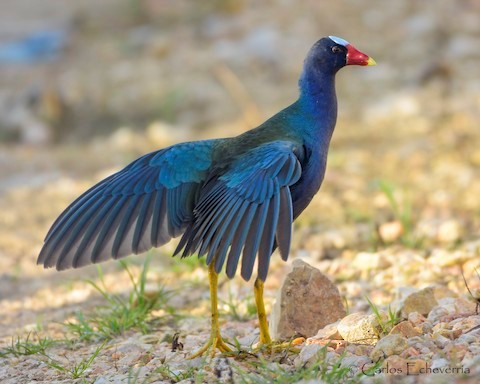
Purple Gallinule, showing vivid blue wings. (San Benito, Petén, Guatemala; February 9, 2017.) © Carlos Echeverría
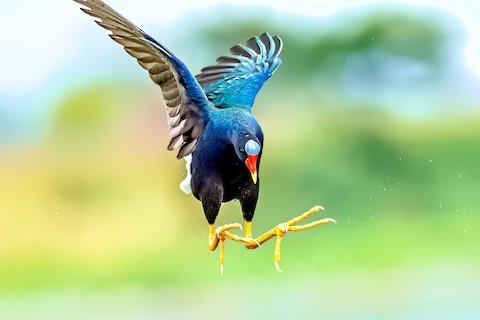
Purple Gallinule, showing vivid blue upperwing and underwing coverts. (La Segua, Manabí, Ecuador; September 22, 2020.) © Pancho Enriquez
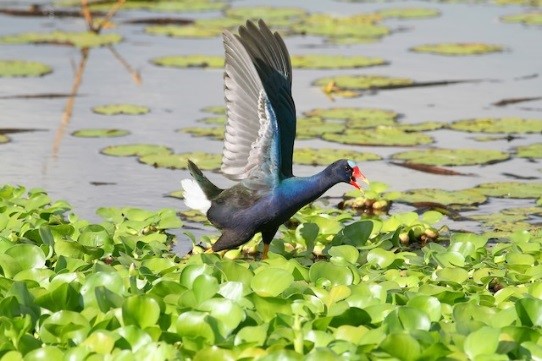
Purple Gallinule, showing blue underwing coverts. (Laguna Cartagena National Wildlife Refuge, Puerto Rico; January 17, 2008.) © Ryan Douglas
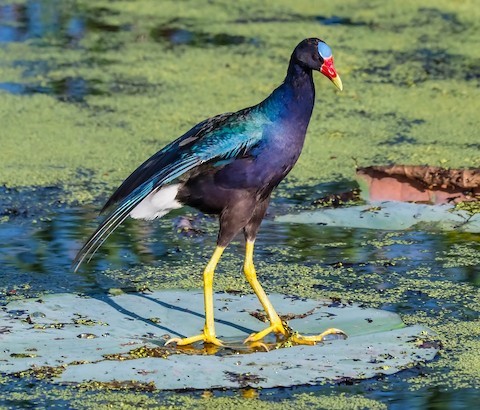
Purple Gallinule, showing black belly contrasting with white undertail coverts and purple breast. (Anahuac National Wildlife Refuge, Texas; July 21, 2017.) © Dwayne Litteer
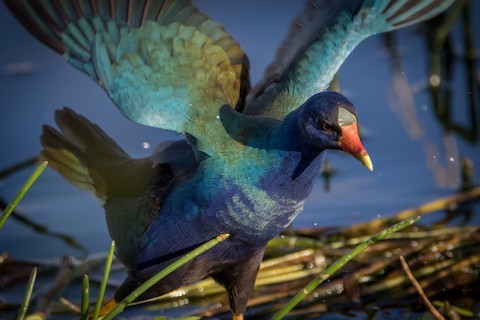
Purple Gallinule, showing atypically dull grayish frontal shield. (Green Cay Wetlands, Palm Beach County, Florida; January 7, 2016.) © Robert Kirk
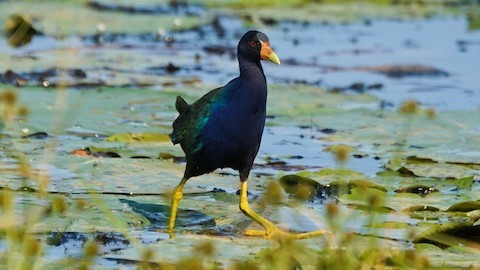
Purple Gallinule, showing generally dark plumage and atypically dull grayish frontal shield. (Pipeline Road, Canton, Mississippi; October 3, 2020.) © Jason Anding

Purple Gallinule, showing mostly turquoise upperparts. (Mauston, Wisconsin; October 18, 2016.) © Joel Trick
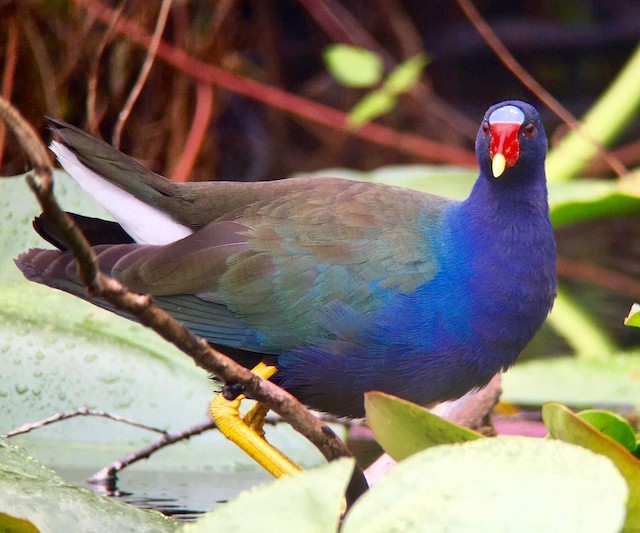
Purple Gallinule. (Shark Valley, Everglades National Park, Florida; January 15, 2016.) © Sharon Stiteler
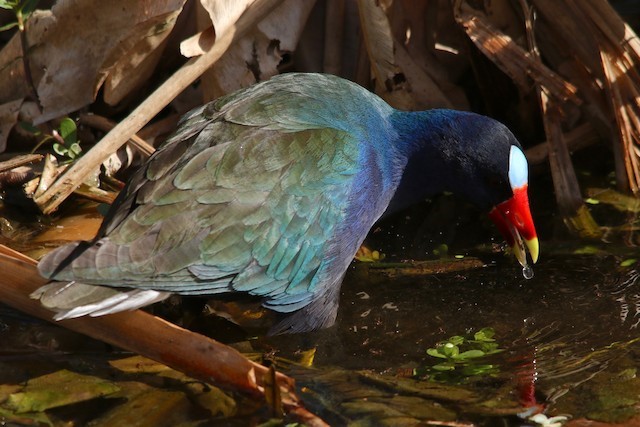
Purple Gallinule. (Green Cay Wetlands, Palm Beach County, Florida; March 28, 2018.) © Benjamin Hack
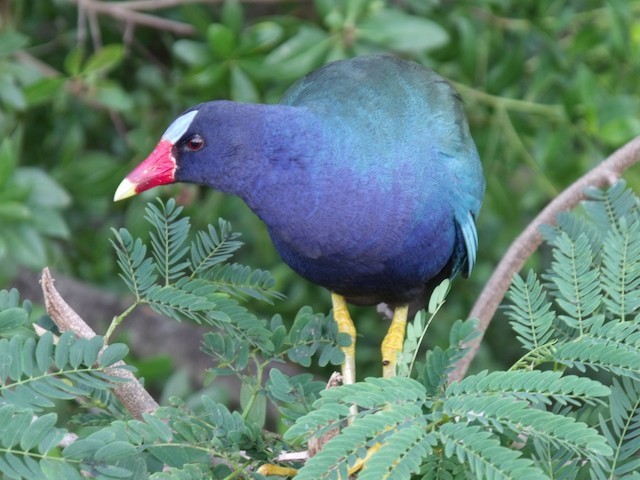
Purple Gallinule, showing mostly blue upperparts. (Bávaro, Dominican Republic; March 10, 2013.) © Steve Charbonneau
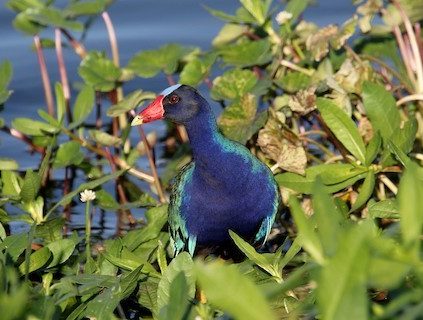
Purple Gallinule, showing blackish face and violet throat, neck, and chest. (Tyrrell Park, Beaumont, Texas; May 13, 2018.) © Stephen Gast
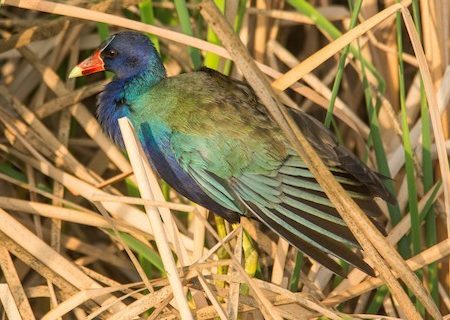
Purple Gallinule, showing extensively bronzy upperparts. (Leonabelle Turnbull Birding Center, Port Aransas, Texas; April 29, 2017.) © Joshua Little
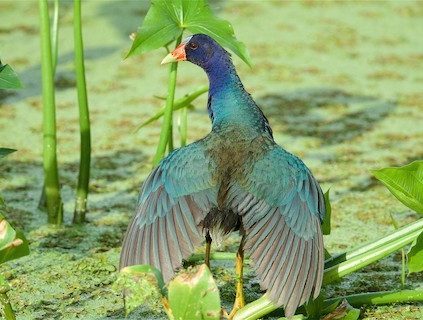
Purple Gallinule, showing extensively blue-green wings and neck, and brownish back. (Tyrrell Park, Beaumont, Texas; August 9, 2020.) © Harlan Stewart
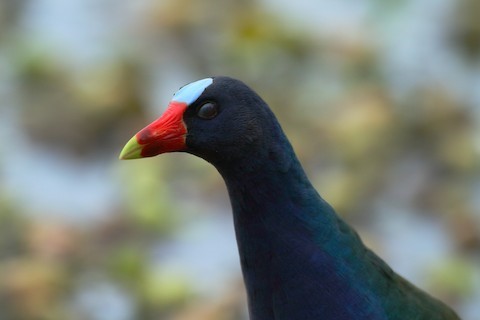
Purple Gallinule. (Lake Parker Park, Lakeland, Florida; October 11, 2016.) © Patrick J. Blake
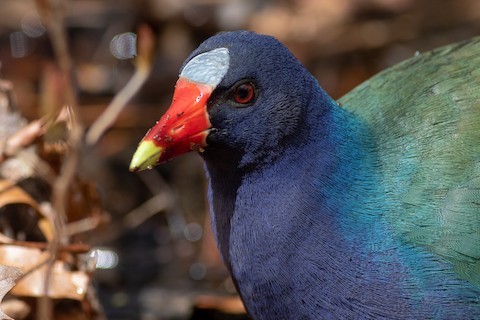
Purple Gallinule. (Dennis Pond, Yarmouth, Massachusetts; May 9, 2020.) © Max Chalfin-Jones
Immature Plumages. Juvenile is mostly buffy, beige, or yellowish on the head, neck, and underparts, pale brown on the upperparts, often with a blue-green cast on the wings. Juvenile’s bill has a pale yellowish tip and darker base. Easily mistaken for the smaller, rarer Azure Gallinule of South America (see below).
Older immatures develop adult plumage and bill coloration in variable progressions, with some retaining mostly brownish plumage while the bill changes color and others developing extensively blue and green feathers before the bill changes.
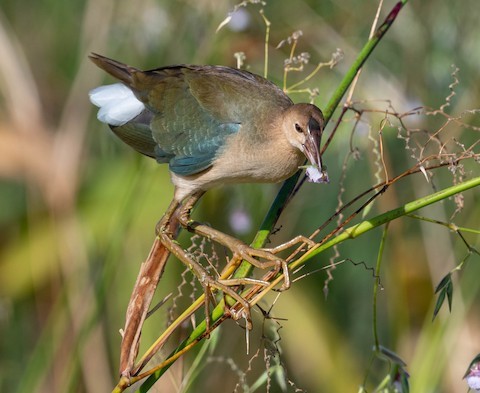
Purple Gallinule, juvenile with blue in the wings. (Peaceful Waters Sanctuary, Palm Beach County, Florida; August 3, 2019.) © David Hall
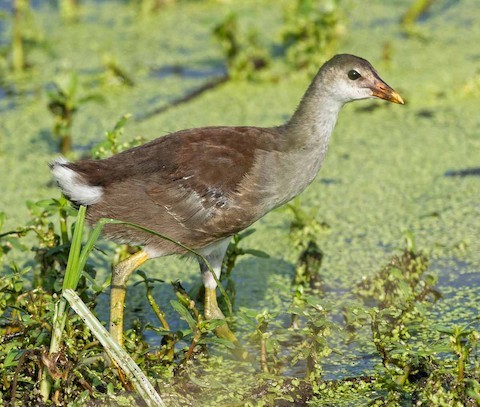
Purple Gallinule, juvenile, brown and whitish gray, and developing yellow and red bill coloration. (Seaman Road Sewage Lagoons, Latimer, Mississippi; July 21, 2016.) © Sewage Team
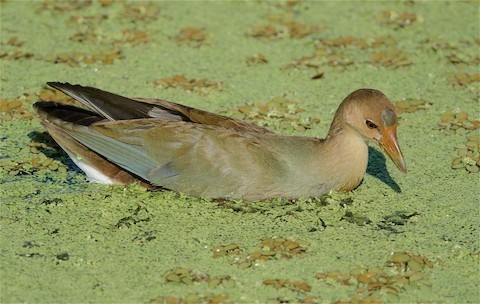
Purple Gallinule, juvenile, swimming, showing bronzy and bluish tints on upperparts and dark frontal shield. (Tyrrell Park, Beaumont, Texas; August 18, 2020.) © Harlan Stewart
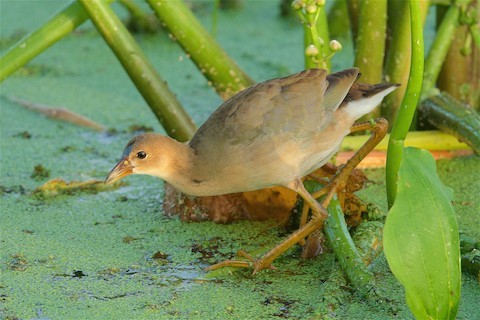
Purple Gallinule, juvenile showing typical buffy-beige plumage. (Tyrrell Park, Beaumont, Texas; September 2, 2020.) © Harlan Stewart
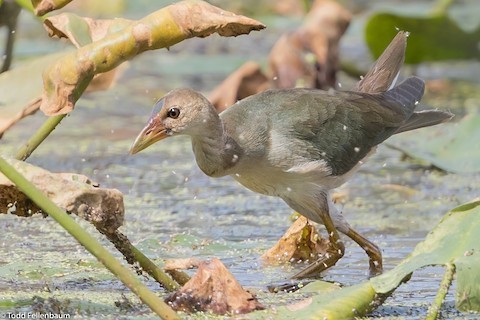
Purple Gallinule, juvenile, a very pale individual. (John Heinz National Wildlife Refuge, Philadelphia, Pennsylvania; September 16, 2019.) © Todd Fellenbaum
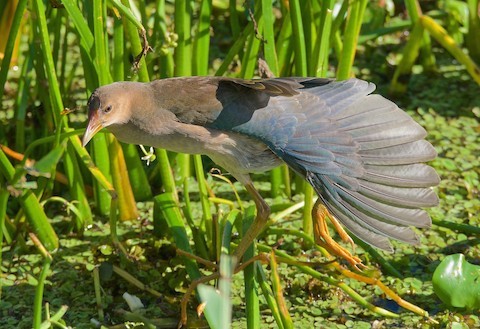
Purple Gallinule, juvenile showing bluish tint on wing. (Tyrrell Park, Beaumont, Texas; October 23, 2017.) © Harlan Stewart
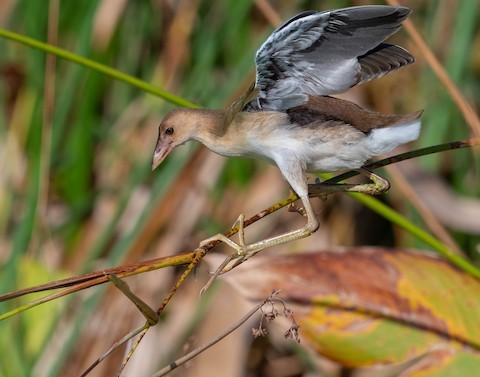
Purple Gallinule, juvenile showing pale-gray underwing coverts. (Peaceful Waters Sanctuary, Palm Beach County, Florida; August 3, 2019.) © David Hall
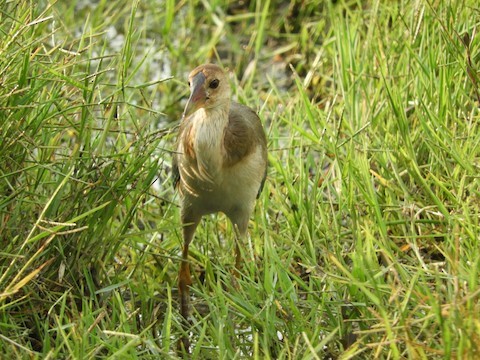
Purple Gallinule, juvenile showing contrasting light and dark areas on the chest. (Parque Acuaparque, Mérida, Yucatán, Mexico; September 23, 2017.) © Luis Trinchan
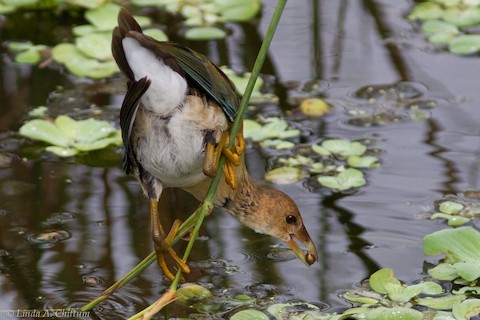
Purple Gallinule, juvenile. (The Celery Fields, Sarasota, Florida; November 9, 2014.) © Linda A. Chittum
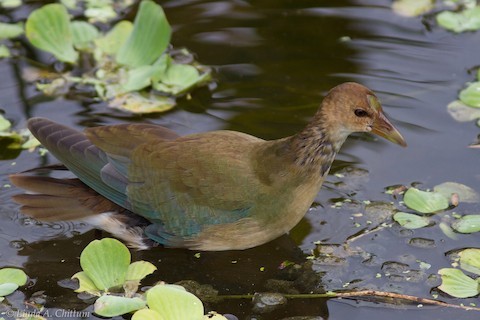
Purple Gallinule, juvenile showing blue in wings. (The Celery Fields, Sarasota, Florida; November 9, 2014.) © Linda A. Chittum

Purple Gallinule, immature with mostly turquoise wings and traces of purple in underparts. (Milton, Massachusetts; October 19, 2019.) © Will Sweet

Purple Gallinule, immature with yellow tip on bill and blotchy green on upperparts and purple on underparts. (Prospect Park, Brooklyn, New York; October 21, 2018.) © Ryan Candee
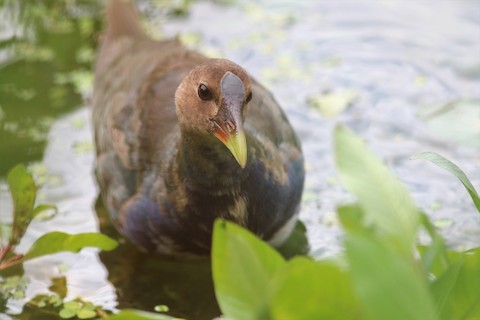
Purple Gallinule, immature with yellow tip on bill and blotchy purple on underparts. (Prospect Park, Brooklyn, New York; October 21, 2018.) © Brendan Fogarty
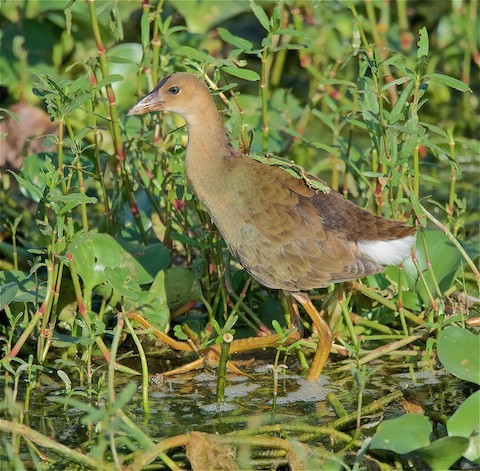
Purple Gallinule, juvenile with a slight bronzy sheen. (Tyrrell Park, Beaumont, Texas; July 9, 2019.) © Harlan Stewart
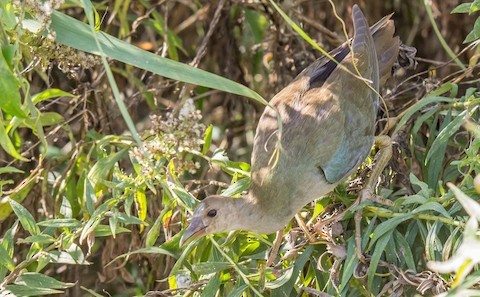
Purple Gallinule, juvenile with a bluish tint in the wings. (Lakeside Landing, Lorain, Ohio; October 21, 2019.) © Ed Wransky
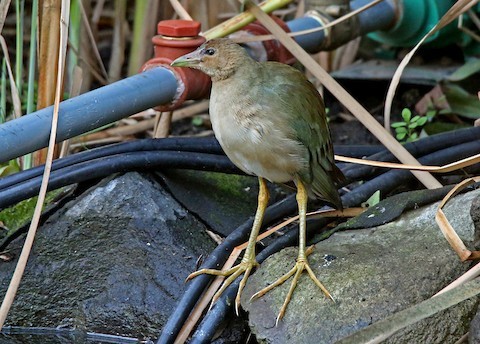
Purple Gallinule, juvenile with a greenish wash. (Parque La Carolina, Jardin Botanico, Quito, Ecuador; March 9, 2019.) © Roger Ahlman
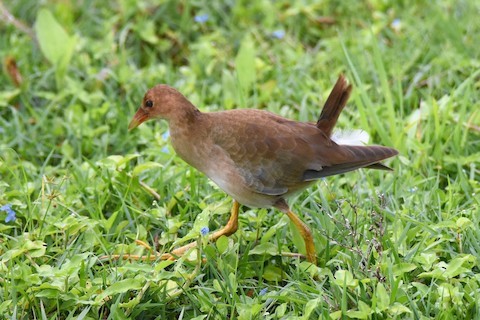
Purple Gallinule, juvenile, all-brown but developing yellow and red bill coloration. (Jubilee Road, Bermuda; December 27, 2017.) © Andrew Dobson
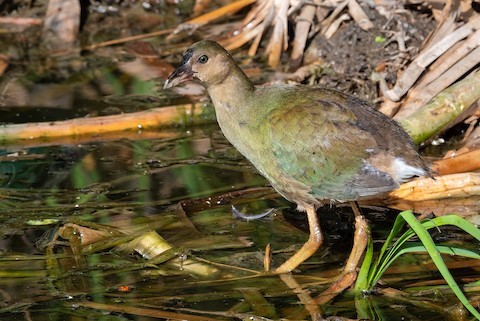
Purple Gallinule, immature with dark bill and partly bronzy upperparts. (Bubali Bird Sanctuary, Aruba; February 26, 2020.) © Don Danko

Purple Gallinule, juvenile developing yellow and red bill coloration. (Corkscrew Swamp Sanctuary, Florida; January 3, 2016.) © Matt Bango
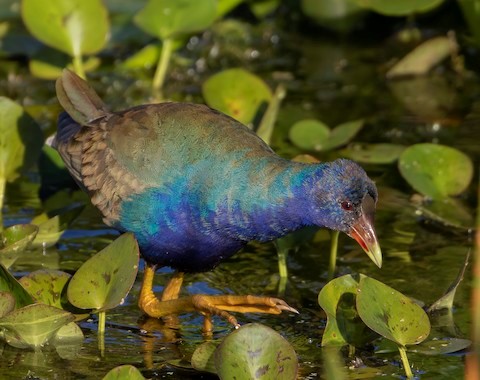
Purple Gallinule, subadult with mostly adult plumage but frontal shield still dark. (Orlando Wetlands Park, Orlando, Florida; February 8, 2020.) © Laurence Taylor

Purple Gallinule, subadult with fully adult plumage, unusually blue upperparts, and dark frontal shield. (Spittal Pond, Bermuda; March 6, 2018.) © Andrew Dobson

Purple Gallinule, subadult with dark bill and extensively bronzy upperparts. (Sumaria Trace, Munroe Settlement, Trinidad; April 3, 2018.) © Jerome E. foster
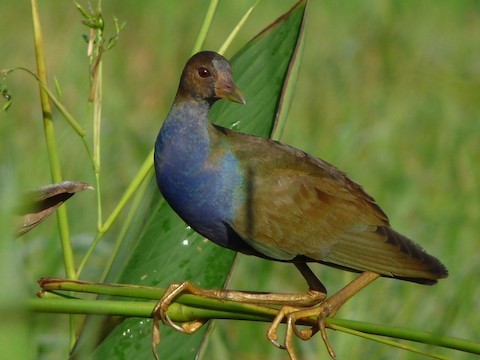
Purple Gallinule, subadult with dark bill and extensively brown upperparts and head. (Rahamut Trace, Siparia, Trinidad; September 27, 2011.) © Sanjiv Parasram
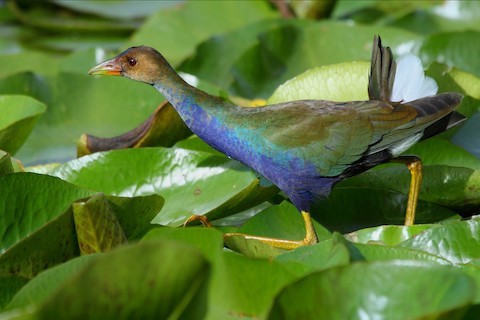
Purple Gallinule, subadult with mostly adult plumage but brown head and dark frontal shield. (Monsanto Forest Park, Lisbon, Portugal; November 8, 2013.) © António Gonçalves
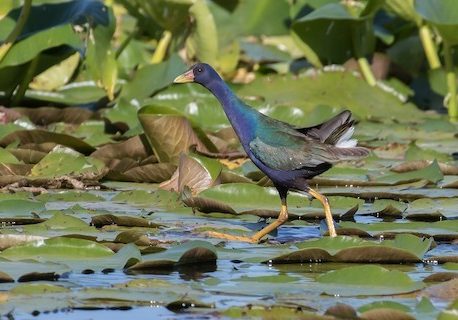
Purple Gallinule, subadult with fully adult plumage but frontal shield still dark. (Lake Seminole Park, Seminole, Florida; March 9, 2020.) © Brett Hoffman
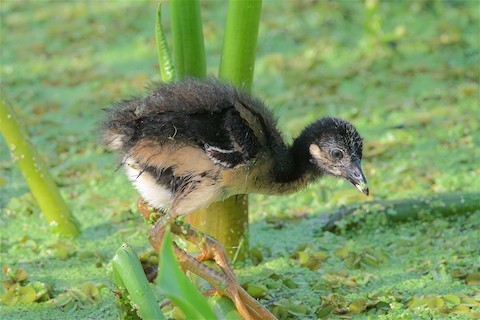
Purple Gallinule, chick. (Tyrrell Park, Beaumont, Texas; August 9, 2020.) © Harlan Stewart

Purple Gallinule, chick. (Tyrrell Park, Beaumont, Texas; August 9, 2020.) © Harlan Stewart
Cf. Azure Gallinule. Across much of South America, immature Purple Gallinule can be mistaken for immature Azure Gallinule. Immature Azure is typically much paler, with whitish underparts, but immature Purple is variable and some individuals also have whitish underparts. Bill color is a more consistent difference: Azure’s bill is uniformly yellowish, whereas Purple’s bill is briefly dark brown in juveniles, then at an early stage begins to show the adult pattern: mostly red with a yellow tip.
Cf. Allen’s Gallinule. The Allen’s Gallinule of Africa has very similar plumage to Purple’s, and differs primarily in having all-red legs and bill. Both species have histories of long-distance vagrancy, with multiple records from western Europe and Macaronesia.
Notes
Monotypic species.
References
Alderfer, J., and J.L. Dunn. 2014. National Geographic Complete Birds of North America (Second Edition). National Geographic Society, Washington, D.C.
Ascanio, D., G.A. Rodriguez, and R. Restall. 2017. Birds of Venezuela. Christopher Helm, London.
BirdLife International. 2016. Porphyrio martinicus. The IUCN Red List of Threatened Species 2016: e.T22692827A93371309. https://dx.doi.org/10.2305/IUCN.UK.2016-3.RLTS.T22692827A93371309.en. (Accessed October 22, 2020.)
eBird. 20 eBird: An online database of bird distribution and abundance. Cornell Lab of Ornithology, Ithaca, N.Y. http://www.ebird.org. (Accessed October 22, 2020.)
Fagan, J., and O. Komar. 2016. Peterson Field Guide to the Birds of Northern Central America. Houghton Mifflin Harcourt, New York.
ffrench, R. 2012. A Guide to the Birds of Trinidad & Tobago (Third Edition). Cornell University Press.
Garcia-del-Rey, E. 2011. Field Guide to the Birds of Macaronesia: Azores, Madeira, Canary Islands, Cape Verde. Lynx Editions, Barcelona.
Garrigues, R., and R. Dean. 2014. The Birds of Costa Rica: A Field Guide (Second Edition). Cornell University Press, Ithaca, N.Y.
Howell, S.N.G., and S. Webb. 1995. A Guide to the Birds of Mexico and Northern Central America. Oxford University Press.
Kirwan, G.M., A. Levesque, M. Oberle, and C.J. Sharpe. 2019. Birds of the West Indies. Lynx Edicions, Barcelona.
McMullan, M., and T. Donegan. 2014, Field Guide to the Birds of Colombia (Second Edition). Fundación Proaves de Colombia, Bogotá.
Mullarney, K., L. Svensson, D. Zetterström, and P.J. Grant. 1999. Birds of Europe. Princeton University Press.
Raffaele, H., J. Wiley, O. Garrido, A. Keith, and J. Raffaele. 1998. A Guide to the Birds of the West Indies. Princeton University Press, Princeton, N.J.
Ridgely, R.S., and P.J. Greenfield. 2001. The Birds of Ecuador, Volume II: Field Guide. Cornell University Press, Ithaca, N.Y.
Ridgely, R.S., and J.A. Gwynne. 1989. A Guide to the Birds of Panama (Second Edition). Princeton University Press, Princeton, N.J.
Ripley, S.D. 1977. Rails of the World: A Monograph of the Family Rallidae. David R. Godine, Publisher, Boston.
Schulenberg, T.S., D.F. Stotz, D.F. Lane, J.P. O’Neill, and T.A. Parker. 2007. Birds of Peru. Princeton University Press, Princeton, N.J.
Taylor, B., and B. van Perlo. 1998. Rails: A Guide to the Rails, Crakes, Gallinules, and Coots of the World. Yale University Press.
van Perlo, B. 2009. A Field Guide to the Birds of Brazil. Oxford University Press, Oxford.
Wells, J.V., and A.C. Wells. 2017. Birds of Aruba, Bonaire, and Curaçao. Cornell University Press, Ithaca, N.Y.
Wikiaves. 2020. Frango-d’água-azul, https://www.wikiaves.com.br/wiki/frango-d_agua-azul. (Accessed October 22, 2020.)
Xeno-Canto. 2020. Purple Gallinule – Porphyrio martinica. https://www.xeno-canto.org/species/Porphyrio-martinica. (Accessed October 22, 2020.)
